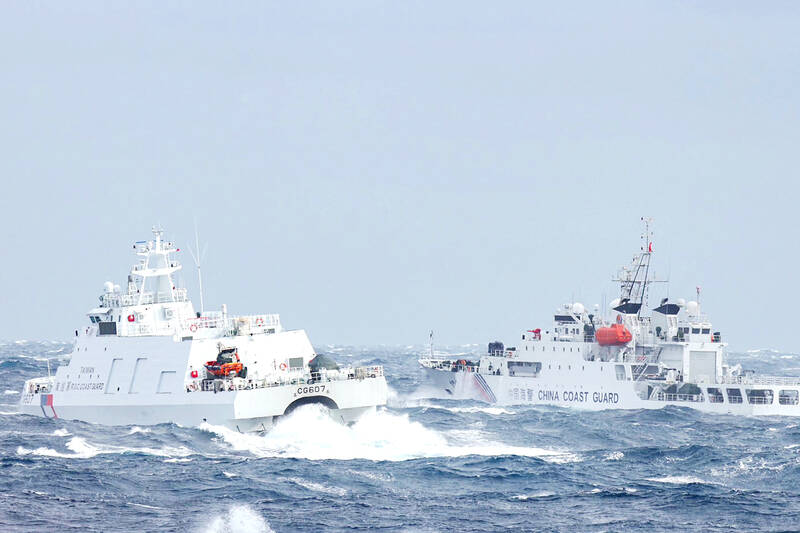The latest military exercises conducted by the People’s Liberation Army (PLA) last week did not follow the standard Chinese Communist Party (CCP) formula. The US and Taiwan also had different explanations for the war games.
Previously the CCP would plan out their large-scale military exercises and wait for an opportunity to dupe the gullible into pinning the blame on someone else for “provoking” Beijing, the most famous being former house speaker Nancy Pelosi’s visit to Taiwan in August 2022. Those military exercises could not possibly have been organized in the short lead time that it was known she was coming.
There is one exception to this rule: the military drills held on June 21, which initially did not appear to be connected to anything. A report in the Liberty Times (the Taipei Times’ sister newspaper) two days later, however, said there had been a secret meeting on June 20 in Taipei involving two US deputy assistant secretaries of state, ambassadors of Taiwan’s 12 formal diplomatic partners and the representatives of friendly countries. This column connected the two as the most likely explanation.

Photo: AFP
Like the June exception, the CCP launched the exercises last week with little advance notice or connected it to anything that annoyed Beijing. It is possible that they were once again sending a message about something not publicly known.
There is another possibility: That this is something new.
THEORIES

Photo: AFP
There are two theories floating about. One is that these exercises were communist crankiness over President William Lai’s (賴清德) recent tour of the Pacific that included Hawaii, Guam and the remaining formal diplomatic partners in the region. The other was muscle flexing as a message to the incoming Trump administration, though it seems more likely that they would have held the exercises closer to his inauguration on Jan. 20.
The problem with both theories is that if they were true the CCP would have said so and cranked up their state-owned mouthpieces into high gear. A senior Taiwanese security official termed the activities as “drills that dare not speak their name.” Instead, they remained silent during the exercises and when asked about them, their spokespersons downplayed them by giving boilerplate responses.
The Global Times reported that Chinese Ministry of National Defense spokesperson Wu Qian (吳謙) said: “As water has no constant form, there are in warfare no constant conditions.” He added: “The PLA will decide whether and when to conduct military exercises in accordance with its needs and the situation on the ground.”
The first line — a quote from Sun Tzu’s (孫子) Art of War — reminds us that the CCP considers itself actively at war (more on the second line below).
TAIWAN STRAIT AS INLAND SEA
Ministry of National Defense spokesperson Sun Li-fang (孫立方) said the scale of the current Chinese naval deployment was the largest since China held war games around Taiwan ahead of the 1996 presidential elections. The American Institute in Taiwan’s (AIT) description was tamer, saying that “PRC military activity is elevated in the region, consistent with levels we have seen during other large exercises.”
Yet AIT also had this to say: “The elevated activity in the East China Sea and South China Sea follows a broader increase in the PLA’s military posture and military exercises over the last several years. With that said, we do not see this wider activity as a response to President Lai’s transit.”
Note “wider activity,” “elevated activity” and “broader increase.” Diplomats choose their words very carefully and including those references was no accident.
Lieutenant General Hsieh Jih-sheng (謝日升) described the drills as a PLA attempt to simulate a blockade on Taiwan and extend forces outward to achieve its anti-access/area denial (A2/AD) objectives. At the same time, it has formed two naval “walls” east of Taiwan to convey the message of “turning the Taiwan Strait into an inland sea” to lower people’s vigilance.
THREE POSSIBILITIES TO WATCH
There are at least three mutually reinforcing new possibilities.
The first is “normalizing” the exercises.
“I clearly believe this is the beginning of the mid-stage of normalization,” said Democratic Progressive Party Legislator (DPP) Chen Kuan-ting (陳冠廷), who sits on the legislature’s Foreign Affairs and Defense Committee.
Secondly, the silence and suddenness of the exercises may be more unnerving, and adds psychological pressure that is more valuable than trying to pin the blame elsewhere.
Others have noted that the Chinese military said after the military exercise that future military exercises could be turned into actual combat at any time depending on the specific situation.
If true, it could suggest they have been thinking about laying the groundwork for a scarier unpredictability that would keep Taiwan’s armed forces, leaders and public perpetually off balance and uncertain.
A third possibility is that Beijing no longer views the messaging as just to Taiwan, but rather the entire region. The increased geographic scale could be preparation for taking on multiple nations at once, but could also include preparation for invading the Senkaku Islands — called Diaoyutai (釣魚台) in Taiwan — or even Ryukyu Islands.
In this context, PLA spokesperson Wu Qian’s quotes above make a lot more sense. During the exercises, the Global Times also ran a piece “Japan ‘doesn’t need to be nervous’ about PLA warships’ Miyako Strait transit: expert.”
For anyone who knows anything about the CCP, this translates as “be very nervous.”
Donovan’s Deep Dives is a regular column by Courtney Donovan Smith (石東文) who writes in-depth analysis on everything about Taiwan’s political scene and geopolitics. Donovan is also the central Taiwan correspondent at ICRT FM100 Radio News, co-publisher of Compass Magazine, co-founder Taiwan Report (report.tw) and former chair of the Taichung American Chamber of Commerce. Follow him on X: @donovan_smith.

The Taipei Times last week reported that the rising share of seniors in the population is reshaping the nation’s housing markets. According to data from the Ministry of the Interior, about 850,000 residences were occupied by elderly people in the first quarter, including 655,000 that housed only one resident. H&B Realty chief researcher Jessica Hsu (徐佳馨), quoted in the article, said that there is rising demand for elderly-friendly housing, including units with elevators, barrier-free layouts and proximity to healthcare services. Hsu and others cited in the article highlighted the changing family residential dynamics, as children no longer live with parents,

Oct 20 to Oct 26 After a day of fighting, the Japanese Army’s Second Division was resting when a curious delegation of two Scotsmen and 19 Taiwanese approached their camp. It was Oct. 20, 1895, and the troops had reached Taiye Village (太爺庄) in today’s Hunei District (湖內), Kaohsiung, just 10km away from their final target of Tainan. Led by Presbyterian missionaries Thomas Barclay and Duncan Ferguson, the group informed the Japanese that resistance leader Liu Yung-fu (劉永福) had fled to China the previous night, leaving his Black Flag Army fighters behind and the city in chaos. On behalf of the

I was 10 when I read an article in the local paper about the Air Guitar World Championships, which take place every year in my home town of Oulu, Finland. My parents had helped out at the very first contest back in 1996 — my mum gave out fliers, my dad sorted the music. Since then, national championships have been held all across the world, with the winners assembling in Oulu every summer. At the time, I asked my parents if I could compete. At first they were hesitant; the event was in a bar, and there would be a lot

The election of Cheng Li-wun (鄭麗文) as chair of the Chinese Nationalist Party (KMT) marked a triumphant return of pride in the “Chinese” in the party name. Cheng wants Taiwanese to be proud to call themselves Chinese again. The unambiguous winner was a return to the KMT ideology that formed in the early 2000s under then chairman Lien Chan (連戰) and president Ma Ying-jeou (馬英九) put into practice as far as he could, until ultimately thwarted by hundreds of thousands of protestors thronging the streets in what became known as the Sunflower movement in 2014. Cheng is an unambiguous Chinese ethnonationalist,